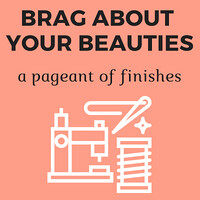Such is the story behind my latest small obsession: thread catchers. I started by cutting out enough pieces for 15 catchers. It may seem like a lot, but what can I say? I have a lot of quilty friends in need of a new thread catcher, and these little projects pack a big scrap- and stash-busting punch. I am using mine to use up:
- Batting scraps
- Canvas scraps
- Essex linen scraps
- Mini charm packs
I have all of those components in spades, but I’m especially excited to put my mini charms to good use. I’ve acquired so many of them over the years -- at QuiltCon, in quilty treat bags, and as thank-you gifts in online fabric orders. With the free pattern I’m following, each pack of 42 squares 2.5" x 2.5" can make panels for 3 thread catchers.
Interested in making your own?
1. Download the free pattern here. (The blog that originally published it is now defunct, but Quilting Digest has a free PDF download.)
2. Open up your mini-charm pack and divide it into 3 groups of 14 squares 2.5" x 2.5". Choose 1 of the 3 groups to work with; set the rest aside.
3. Cut each of 10 squares 2.5" x 2.5" into 2 rectangles 1.25" x 2.5" (for a total of 20 rectangles 1.25" x 2.5"). Trim each of the remaining 4 squares 2.5" x 2.5" down to 1 rectangle 1.5" x 2.5", discarding the scraps (for a total of 4 squares 1.5" x 2.5").
4. Following the instructions in the pattern, layer your canvas and batting to create 2 panels. If you don’t have leftover canvas on hand, think of other more-substantial scraps you might have used for home-dec or bag-making projects. They may do the trick!
5. Start to build the quilt-as-you-go patchwork with your mini-charm pieces. Begin the patchwork on each panel with 1 rectangle 1.5" x 2.5". Then sew 10 rectangles 1.25" x 2.5". End with 1 rectangle 1.5" x 2.5".
6. Continue to follow the instructions to complete the thread catcher.
I veered from the instructions in minor ways: Because the Essex linen I was using shifted a bit, I found that I had to trim up my panels after quilting them. Also, for my first thread catcher, I finished my binding by machine. It wasn’t neat enough for my liking, though. After that, I used a contrasting 12 weight thread to finish the remaining catchers with visible chunky stitches. (If you want to give that a try, check out the tutorial here.)
I am a big fan of making simple projects en masse to give away as gifts. These beauties could even be billed as baskets and given to nonquilty people in your life.
Do you set up sewing production lines to make gifts, too? I’d love to hear about the small gifts you conquer in the comments!
Follow Me On ...
The pageant rules are simple:
- Post your finish in the linky tool. (No links to your own giveaway or linky, please!)
- Point your readers back here with a text link or use the button above.
- Visit and comment on other participants’ finishes.















